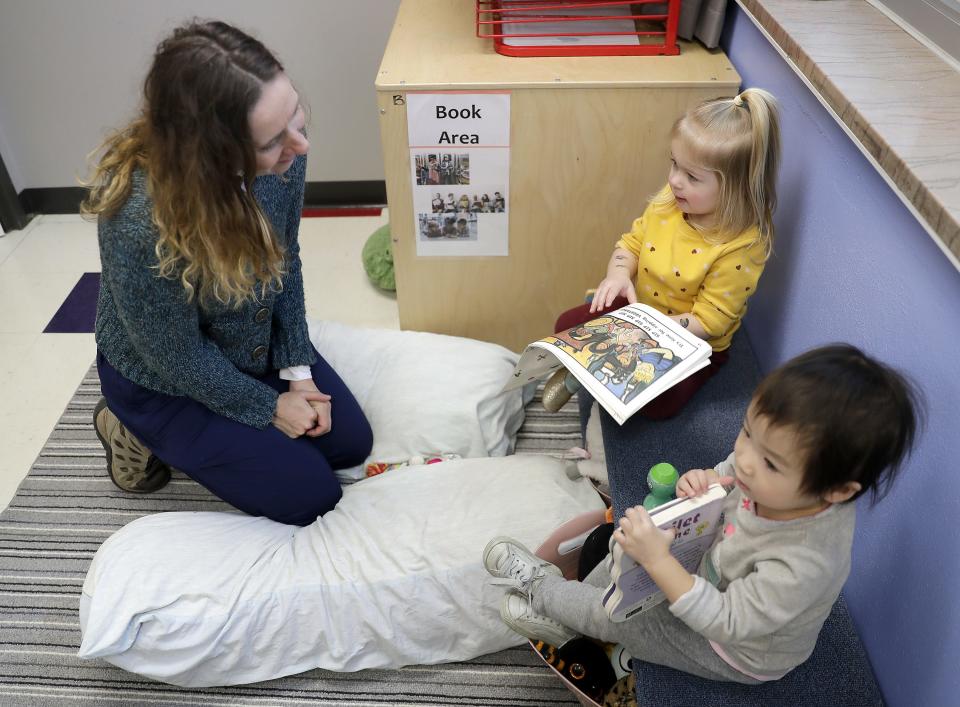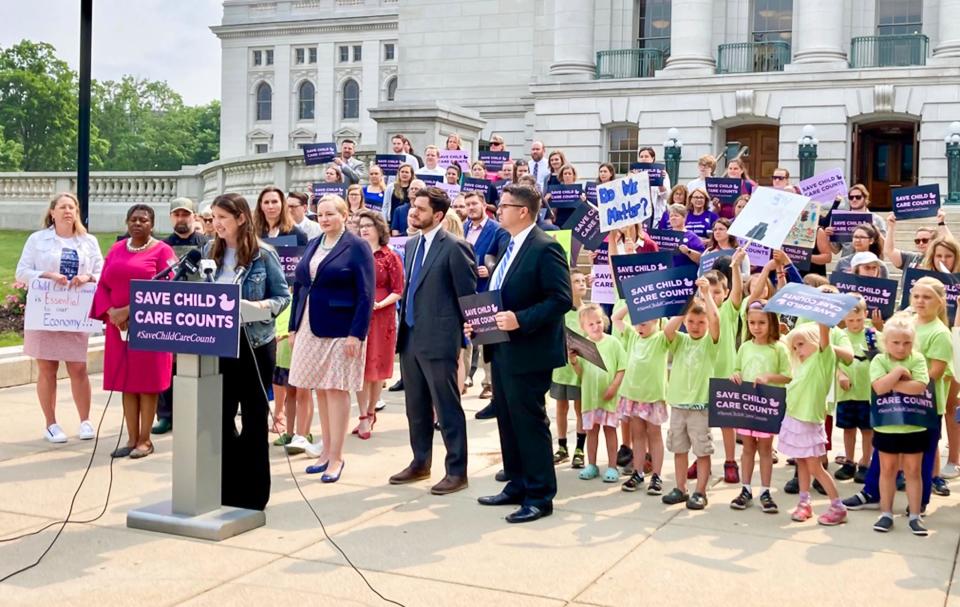Wisconsin Democrats talk a lot about Child Care Counts. But what is it?
- Oops!Something went wrong.Please try again later.
As lawmakers continue to debate how — and whether — the state should step in to relieve families of child care struggles, Democrats continue to champion Child Care Counts.
Since its inception in spring 2020, the program that directs funding to supporting child care businesses has undergone several iterations, and, at one point, was set to run out of money by this year.
Here’s what you need to know about Child Care Counts, from its early days to how it functions today.
What is Child Care Counts?
Child Care Counts began during the pandemic as a way to support child care businesses and, by extension, families, throughout the pandemic. It does this by directing federal pandemic relief funding to regulated child care programs across the state to help them stay open, provide high-quality care to children and weather staffing shortages.
The Wisconsin Department of Children and Families administers the program.
Since the program started, over $711 million has gone directly to child care providers, and it has helped over 5,100 child care providers stay open, DCF communications director Gina Paige said. This has enabled providers to continue to care for more than 349,300 children, she said.
How does Child Care Counts work?

The current version of Child Care Counts, the Child Care Counts Stabilization Payment Program, distributes monthly stabilization payments to regulated child care programs across the state. The current version started in November 2021 and is set to run through June 2025.
There are two sub-programs: Program A , which focuses on increasing access to high-quality care, and Program B, which focuses on funding workforce recruitment and retention. Each program has specifications for how child care programs can spend the funds.
How much money a child care business receives under Program A depends on the number of children enrolled, with add-ons for providers participating in the Inclusive Birth to 3 Child Care Pilot and each child who is authorized to receive Wisconsin Shares, the state’s subsidy program that helps families afford child care, Paige said.
For Program B, the amount a program receives depends on staffing specifications and the provider’s ranking on YoungStar, the state’s voluntary quality rating system.
Providers submit records for a specified week and then receive payments the following month. They have 120 days from the date of the payment letter to spend the funds.
Related: Wisconsin is altering its child care subsidy program. Here’s what families need to know.
How do child care providers use Child Care Counts?
A study by the University of Wisconsin-Madison Institute for Research on Poverty found the most commonly reported use of Program A funding among study participants is for physical operating expenses, such as rent and utilities. This was followed by materials and supplies for enhancing the program and then payroll and benefits.
The most commonly reported uses of Program B funding were for bonuses or stipends for current staff, followed by increased hourly wages or annual salaries.
Wages for Wisconsin’s child care workers are notoriously low; the median hourly wage for a Wisconsin child care worker was $12.66 per hour in 2022, even with Child Care Counts help. Low wages contribute to the field's staffing shortages, which limits the number of child care slots in Wisconsin.
Child care providers previously told USA TODAY NETWORK-Wisconsin that Child Care Counts helped them prevent substantial cost increases for families.
Often, the price families pay for child care is one of the few sources of revenue for child care businesses, and child care programs typically have tight budgets. This means that to increase wages to help battle staffing shortages, child care businesses need to charge families more.
Child Care Counts provides another consistent source of revenue for child care programs. A Wisconsin Early Childhood Action Needed (WECAN) survey of over 500 child care providers found, on average, Child Care Counts funding makes up 25% of a child care business’s revenue.
Many providers credit the program with keeping their doors open, helping to prevent families from losing the child care they depend on to work.
Child Care Counts was set to end. Why didn't it?

Child Care Counts is largely funded by one-time pandemic-era relief funds. These funds were set to run out early this year, ending the program.
Knowing this, Democrats and advocates pushed for the state to allocate funding to continue the program in the 2023-25 biennial budget. Republicans, many of whom are advancing other proposals they say will help the child care industry, said no.
More: Republican lawmakers block extending pandemic-era program Child Care Counts
For a while, it looked as if the program would end come 2024, until Democratic Gov. Tony Evers announced in October he was directing $170 million of emergency funding to the program. Much of the money was unspent pandemic relief funds originally allocated elsewhere; now, it will continue the program through June 2025.
More: Gov. Tony Evers announces $170M in 'emergency funding' to extend Child Care Counts
Has Child Care Counts experienced cuts?
Evers, himself, described the funding as a “stopgap measure.” He acknowledged this is one-time funding and said sustainable investments need to be made by June 2025 into the child care industry to prevent Wisconsin from facing the same fiscal cliff it narrowly avoided this year.
Evers said this would allow the Child Care Counts Stabilization Payment Program to continue operating at reduced funding levels first enacted in May 2023, which equated to about $10 million per month. However, DCF was able to move unspent federal money to the program, allowing the program to use $12 million per month from May 2023 to January 2024, Paige explained.

As of March, the program will have $10 million each month, Paige said. With this change, DCF estimates child care providers will see payments at 80% of what they saw the previous month. The exact amount a provider receives depends on specifics of their program.
In response to the May funding cut, and the feared end of Child Care Counts, multiple providers told USA TODAY NETWORK-Wisconsin they raised rates. Some even closed, said Corrine Hendrickson, WECAN co-founder and owner and operator of Corrine’s Little Explorers, a family child care program in New Glarus.
What other child care help measures have lawmakers discussed this session?
Earlier this month, Evers signed a bipartisan law that will expand a state tax credit for children’s and other qualifying dependents’ care expenses that are necessary for taxpayers to earn income.
The new law alters the state’s Child and Dependent Care Expenses Tax Credit so that in many cases it will surpass its federal equivalent beginning with the state income taxes filed in spring 2025.
During the budget process, lawmakers decided to make changes to Wisconsin Shares, the state's child care subsidy program. For example, this summer, the initial eligibility threshold to qualify for the program will move from 185% to 200% of the federal poverty level.
A bill that would create a revolving loan fund for regulated child care programs is now headed to the governor’s office.
This bill is one of six in a Republican child care bill package introduced in early September. As of March 11, it appears unlikely the other five bills, many of which propose changing child care regulations and largely drew mixed reactions from child care providers, will make it to Evers desk this legislative session.
Republicans have also proposed changing the state’s public 4K structure so school districts that offer 4K would have to contract with eligible child care programs to do so. The bill never reached the Assembly floor, and so it will not make its way to Evers this session.
In addition to altering 4K, Republicans have also proposed bills that they hope will incentivize employers to help workers with child care challenges. One of these bills, which would alter the business development tax credit, has passed in the Assembly and passed this week in the Senate. The other, which would create new tax credits for employers, did not reach the Assembly floor and therefore will not go to Evers this session.
Related: Wisconsin's legislative session is wrapping up. What have lawmakers done on child care?
Related: New 4K bill could help child care, but at the expense of schools?
Madison Lammert covers child care and early education across Wisconsin as a Report for America corps member based at The Appleton Post-Crescent. To contact her, email mlammert@gannett.com or call 920-993-7108. Please consider supporting journalism that informs our democracy with a tax-deductible gift to Report for America by visiting postcrescent.com/RFA.
This article originally appeared on Appleton Post-Crescent: Wisconsin Democrats talk a lot about Child Care Counts. But what is it?

